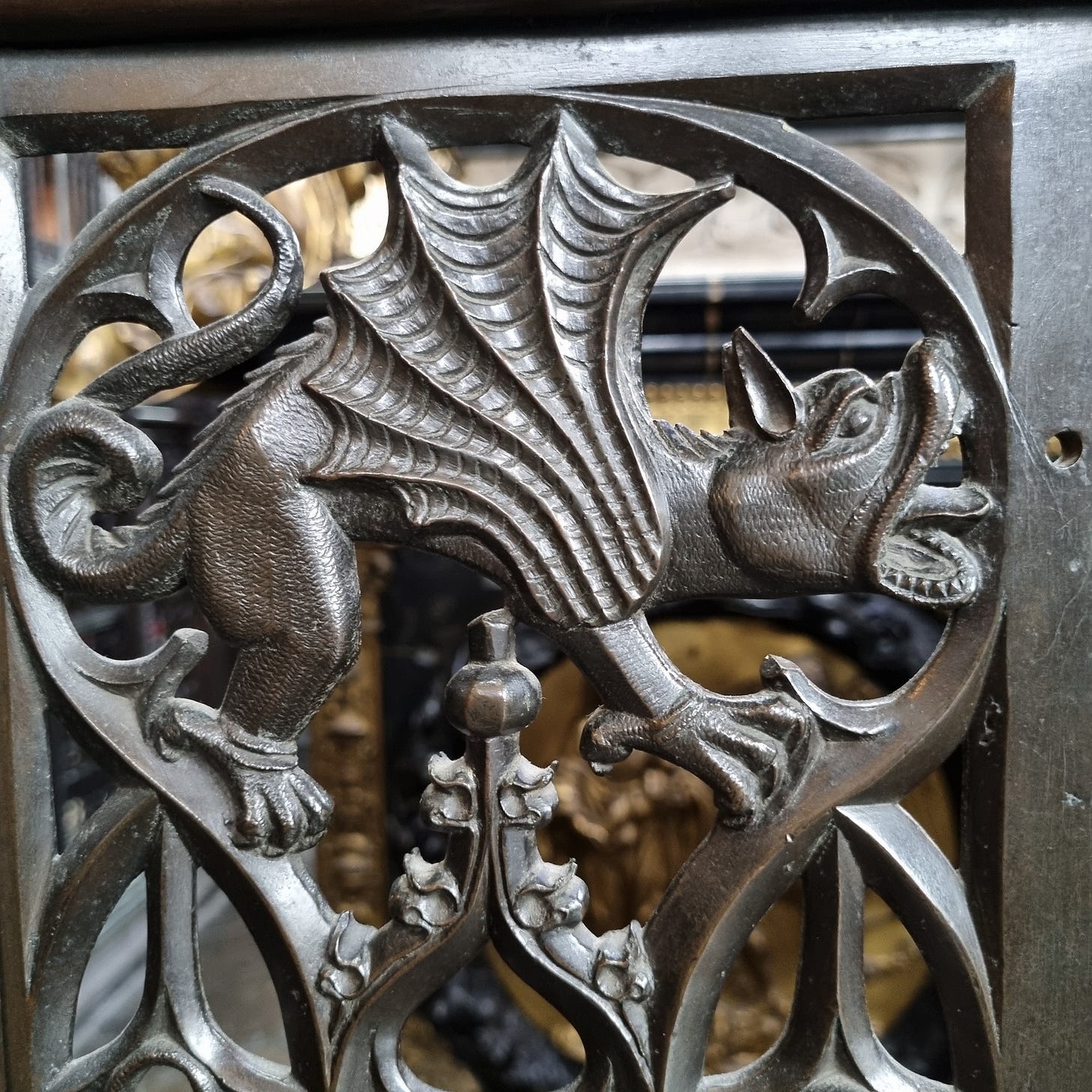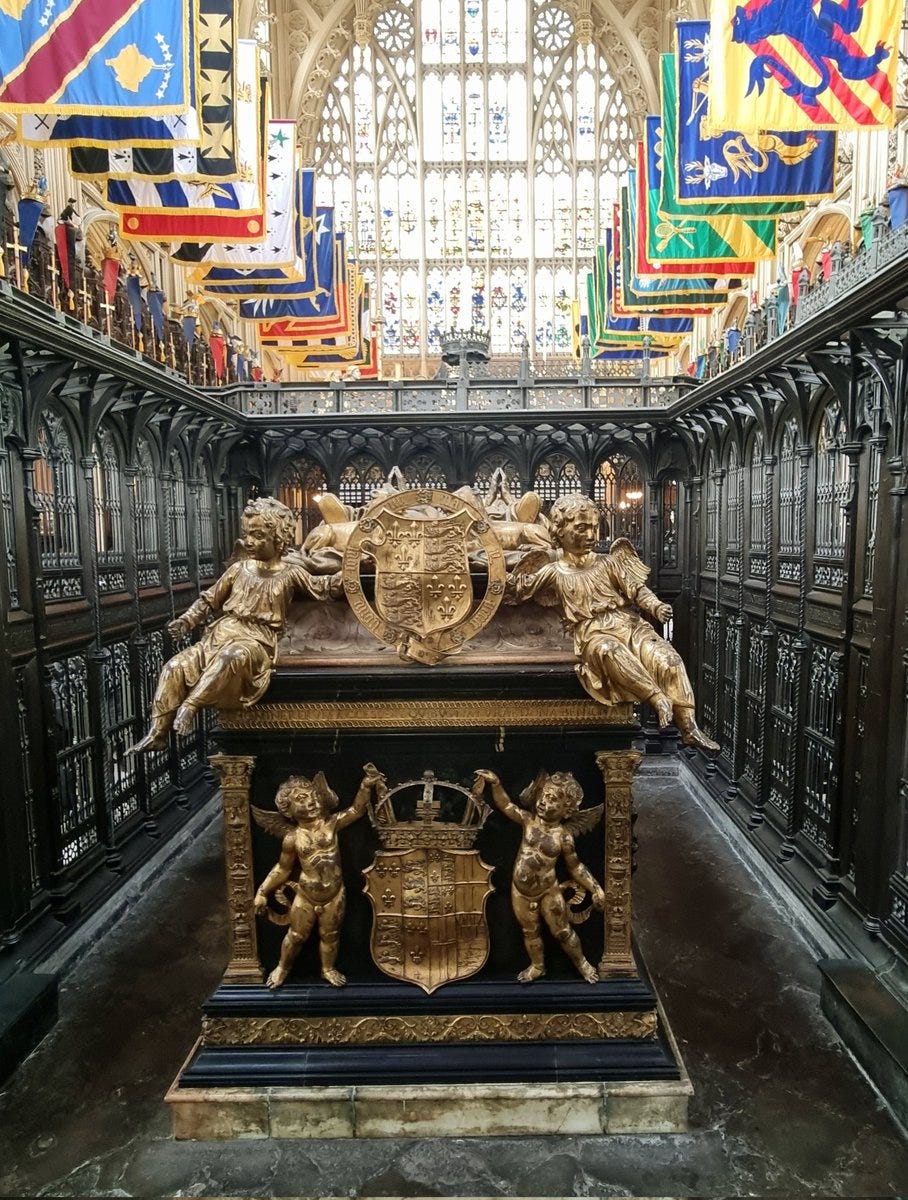Spotlight On...Westminster Abbey and Henry VII's Lady Chapel
The 'wonder of the entire world'
This past weekend I had the opportunity to play tourist for the day and pay another visit to Westminster Abbey. Thankfully, since my last visit they have relaxed their stringent rules on photography, so I seized the chance to capture some images of Henry VII’s tomb and chantry chapel. I know, predictable, right?
Westminster’s Lady Chapel, at least the one that we know and love today, was built between 1503 and 1512 on the orders of Henry VII, and with a spectacular fan vaulted roof with hanging pendants was described by John Leland in 1545 as ‘the wonder of the entire world’. The first stone was laid at exactly 2:45pm on 24 January 1503 and the design was certainly unconventional for the time. Over that century, it served as the Tudor Dynasty’s personal mausoleum – among those buried within the breath-taking chapel are Margaret Beaufort, Henry VII, Elizabeth of York, Edward VI, Mary I, Mary Queen of Scots, and Elizabeth I.
The chantry chapel itself, essentially a small chapel within a chapel, which contains the joint tomb of Henry VII and Elizabeth of York has pride of place, situated behind the main altar. It was designed by Thomas the Dutchman and begun in 1505, four years before Henry VII’s death.
Henry left very specific instructions in his will about how he wanted his tomb and chantry chapel to appear. He wanted the small altar to be serviced by three chantry priests, and provided an alleged piece of the Holy Cross encased in gold and garnished with pearls and precious stones to be placed on the altar during certain feast days.
The chapel was encircled by an elaborate iron grill, upon which Tudor family emblems like the Welsh dragon, Richmond greyhound and Beaufort portcullis are present. Upon this grate a provision was made for one hundred tapers standing nine feet long to be placed, which according to the king’s instructions were to be lit on appropriate anniversaries, during the principal feasts, and whenever any reigning king or queen stepped foot into the abbey.
Four protruding brackets to hold tapers were also placed on each side of the grate, each containing an eye-catching crown-shaped drip pan. If the monks failed in their duties to light the candles, they were fined as per the agreement struck with Henry VII in 1504.
The sculptor tasked with producing the bronze and marble masterpiece contained within the chantry was Pietro Torrigiano, a Florentine banished from his homeland for a string of violent incidents which culminated in breaking the nose of his colleague, Michelangelo. Torrigiano’s work captured a remarkable likeness of the king and queen, lying side-by-side with their hands clasped in prayer.
In each corner were positioned four gilt bronze angels, with those on the east end holding aloft the royal arms with a pair of cherubs supporting the arms of the queen below. Designed heavily in the Italian manner, the tomb was far more ornate than anything of its kind seen in England before that period, surpassing all previous examples which only served to amplify Henry’s prestige to anyone who had reason to view the structure in person.
If a tomb told the story of the man buried beneath, then Henry VII was surely greatest king England had ever known, the intended reaction it was designed to stir.
When one factors in the Lady Chapel in which it stood as the central attraction, Henry’s resting place was possibly the finest of any English monarch, surrounded by a profusion of Tudor royal emblems and badges covering almost every inch of the building, on the stone walls, intricately carved into the wooden stalls, fixed to the brass doors, and even in the stained glass.
Elsewhere in the Lady Chapel, near the tomb of Elizabeth I, is Innocents Corner. Here lie the remains of two children who died of natural causes (Princesses Maria and Sophia, daughters of James I), but also allegedly so too do the remains of two boys who were supposedly murdered. After bones were found in the Tower of London in 1674 and rashly identified as that of the Princes in the Tower, four years later Charles II had Christopher Wren design a white marble monument to house an urn containing the remains.
The Latin transcription reads:
"Here lie the relics of Edward V, King of England, and Richard, Duke of York. These brothers being confined in the Tower of London, and there stifled with pillows, were privately and meanly buried, by the order of their perfidious uncle Richard the Usurper; whose bones, long enquired after and wished for, after 191 years in the rubbish of the stairs (those lately leading to the Chapel of the White Tower) were on the 17th day of July 1674, by undoubted proofs discovered, being buried deep in that place. Charles II, a most compassionate prince, pitying their severe fate, ordered these unhappy Princes to be laid amongst the monuments of their predecessors, 1678, in the 30th year of his reign".
Whether they are, of course, the mortal remains of Edward V and his brother Richard of Shrewsbury remains a matter of debate and conjecture. Do pay a visit if you’re ever in London, though be warned, it does get busy!
Son of Prophecy: The Rise of Henry Tudor is on sale from July 2024, available from all good bookshops (online and in store). Pre-Order NOW.















I was there 2 weeks ago and not only did my friend and I spend a lot of time in Henry VIi’s Lady Chapel. We paid the extra 5 to go to the Queen’s Diamond jubilee galleries where the royal effigy collection is housed. You can look Henry VII in the eye up there
Wonderful photos! I hadn't been in some years, so when my hubby and I were in the UK for 3 weeks last summer, we did buy tickets ahead (almost a requirement) and it was absolutely mobbed. The Henry VII chapel was so crowded, we could barely get inside. I did manage a few photos, but wow, first time I've seen it like that. Tourist buses dropping large groups off, etc. It was a Saturday, so probably my first mistake. Still worth it, though, as we did get a good view of the coronation chair and enjoyed Poet's Corner. The Henry VII Chapel is truly spectacular and a sight everyone should see on a visit to London! I still enjoy the fact that Elizabeth I and Mary I are buried in the same tomb, with Elizabeth's effigy on the top.